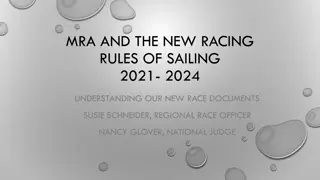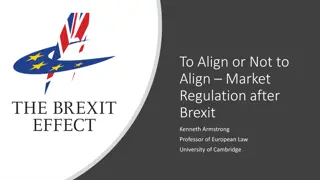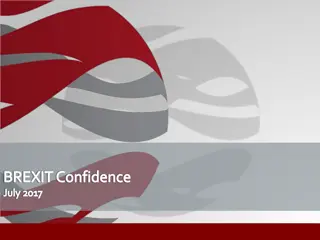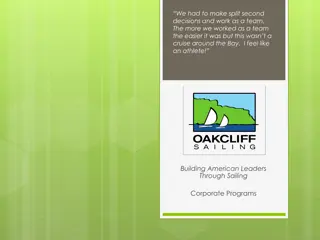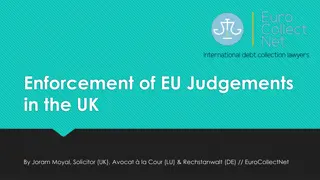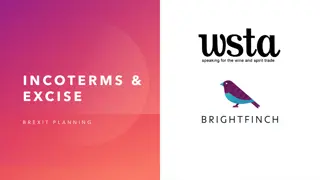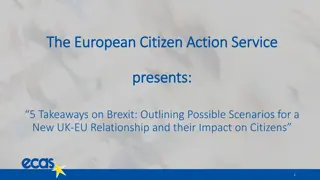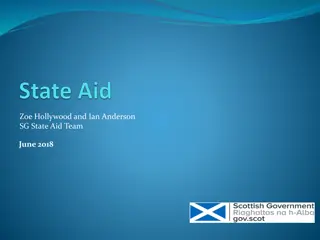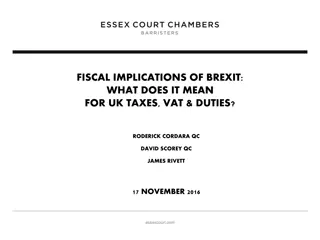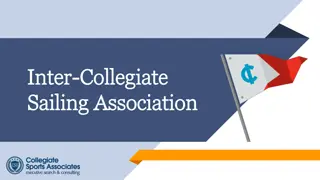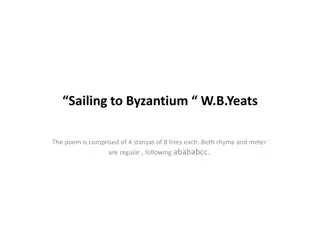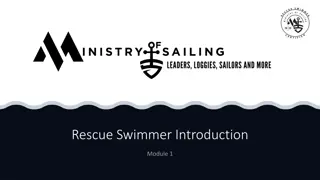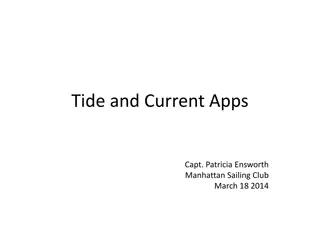Sailing to Europe After Brexit: Rules and Regulations for UK Boaters
Understanding the new rules and regulations for UK boaters sailing to Europe post-Brexit is crucial. With the UK now considered a third country, there are separate requirements for both individuals and boats entering the EU. Learn about Temporary Admission rules, EU VAT liability, Schengen agreements, visa requirements, and more.
Download Presentation

Please find below an Image/Link to download the presentation.
The content on the website is provided AS IS for your information and personal use only. It may not be sold, licensed, or shared on other websites without obtaining consent from the author. Download presentation by click this link. If you encounter any issues during the download, it is possible that the publisher has removed the file from their server.
E N D
Presentation Transcript
Sailing to Europe, Sailing to Europe, What you need to know. What you need to know. Now that the UK has left the EU, to the EU the UK has become a 3rd country. This means that we must abide by rules and regulations for 3rdcountries. These are new to us, but not to other non-EU countries.
The Basics The Basics - - for the EU and EEA for the EU and EEA 1. The rules and regulations for people and the rules and regulations for boats entering the EU are completely separate 2. The rules and regulations for people are covered by the Schengen agreement and individual countries immigration laws. 3. Importation rules and regulations for boats entering the EU are covered by EU customs regulations.
Your boat and EU Customs Your boat and EU Customs Below is a very simplified explanation of the rules. 1. If your boat was in the UK at 23:00 hrs. on the 31st December 2020 then the boat on entering the EU can remain in the EU for 18 months under Temporary Admission rules, after which point EU VAT becomes liable. At any point the clock can be re-set by exiting the EU and then re-entering. For example a boat in France could sail to the UK and stay for one night, and on return the 18 month clock would start again. 2. If your boat was in the EU at 23:00 hrs. on the 31st January 2020 then the boat will have Free Circulation status and has no limit on time or travel within the EU. If the boat leaves the EU it can return within 3 years without incurring a VAT charge by claiming Return Goods Relief (RGR).
People People - - Entry into the EU Entry into the EU - - Schengen Schengen 1. Now that the UK has left the EU we are now termed as a 3rd country, like America, China and most other non-EU nations. 2. Citizens from 3rd countries can visit the EU, with or without a Visa, for up to 90 days in any 180 days. UK citizens do not require a Schengen Visa. A calculator is available at: https://ec.europa.eu/assets/home/visa-calculator/calculator.htm?lang=en 3. Individual countries can have other arrangements for citizens of 3rd countries. France offers a 6 month (and a 12 month) visa. The 6 month Visa is a Visa de Long S jour (Temporary). Sweden offers a 6 month Swedish Visitors Residence Permit. Spain, Portugal and Greece may offer something in the future.
Schengen Visa Calculator. Schengen Visa Calculator.
Schengen Countries comprise most EU Countries (but NOT Bulgaria, Ireland, Romania) plus Iceland, Lichtenstein, Norway, Switzerland.
Documentation required Documentation required 1. Registration papers will regularly be inspected in most countries. UK vessels cruising in UK waters do not have to register. However, without ship's registration papers, you cannot prove the vessel's nationality in another country (anyone can fly a flag). So, to go foreign, UK boats will need to be registered (part1or SSR) with the Maritime & Coastguard Agency (MCA). The original part 1 registration certificate, or Part 3 SSR registration certificate must be carried. It is often acceptable to present a copy, but some authorities insist on originals, so carry the original.
2. Third Party Insurance. A certificate (often in the local language) confirming third party insurance will be required in many marinas and ports. Also, some countries insist on third party insurance. In these places, certificates will often be inspected. All insurers will supply a certificate (in local language, including level of cover where that is relevant) on request. The original yacht insurance policy (not a copy) should also be carried, but will only rarely be asked for. Many policies have geographical limitations. Ensure yours covers your intended cruise area.
3. Ship's Radio Licence. If you have any transmitters aboard, you are legally required to carry a ship s radio license covering all the transmitting equipment including handheld transmitters. This is very rarely asked for. In addition, if you have a VHF license from Ofcom, then you are required to show that you comply with Ofcom's license conditions relating to EMF emissions.
4. Crew Lists. Some countries expect you to carry a crew list. These are occasionally used to control the number of crew who may use the boat over a period of time (Croatia, Turkey) and the list must be endorsed whenever crew changes occur. Crew lists will identify your vessel with detail from your registration certificate, also the area or route you are cruising. The list gives personnel and role aboard (skipper, crew), plus details from passports (nationality, name, passport number, date of birth). They can always be made out on first arrival in a country, often by completing a locally supplied form.
5. Passports. Most European countries require identification to be carried at all times. Make sure your passport will be valid for your trip, and cover the period of any visas you may be issued. For non- EU passport holders travelling to the EU, your passport must be valid for 3 months after the day you plan to leave. In addition, your passport must be issued less than 10 years before the day you enter the EU. Non-EU passport holders must abide by the 90-day Schengen limitations.
6. International Certificate of Competence (ICC). Many European countries expect captains of visiting vessel to be licenced and will occasionally ask for a certificate of competence. This often happens after any incident afloat. An 'International Certificate of Competence' (ICC) issued by the Royal Yachting Association is accepted throughout Europe, even though it has not been ratified by all countries. Typically, after an incident, if you do not carry proof of competence, the authorities will not permit you to leave port until your competence is proven. Carry an ICC to avoid difficulties.
7. Radio Operator's Certificate. One person aboard must have an operator s certificate for each type of transmitter. This is very rarely asked for. 8. CEVNI. To travel on inland waterways a 'Code Europ en des Voies de Navigation Int rieure' (CEVNI) endorsement will be needed on your ICC. In some waters, it is necessary to carry a copy of the CEVNI code itself, even though it may be in a language that you cannot read.
9. Equipment Certificates. Registered craft in many countries are subject to checks that life-rafts are serviced, flares up-to-date, and approved navigation lights fitted. UK registered craft (unless they are trailer launched locally) don t have to carry such equipment or certificates. However, you may occasionally be asked for them, so carry any you have. There have been reports of fines for carrying out of date stock (flares). 10.VHF on Waterways. When travelling on Europe's inland waterways your VHF has to meet ATIS standards. Using a DSC enabled VHF on inland waterways is prohibited.
10. Ship's Log book. This should be kept up to date. 11. Health. UK citizens travelling to the EU should carry their UK general Health Insurance Cards (GHIC) to show entitlement to treatment. Existing EHICs are also valid until their expiry date (5 years from issue). Medical treatment in the Channel Islands (not part of the EU health scheme) must be paid for.
Red Diesel When visiting a foreign country, such as the EU 27 States and Northern Ireland under the Northern Ireland Protocol (Withdrawal Agreement) after 1st October 2021, the presence of UK red diesel in the tank(s) of boats is permitted by the Istanbul Convention 1990 (Temporary Importation). Under the SOLAS V regulations this includes the carriage of red diesel in approved spare fuel containers. Fuel purchase receipts should be available for inspection if required.
Arrival and Departure Arrival and Departure The UK is now a Third Country with respect to the EU and procedures for vessels sailing between the UK and all of the EU and Schengen countries have changed. The following is based on current understanding of regulations of both the UK government and EU and Schengen countries. BUT please note that the regulations for arrival in and departure from Northern Ireland are different to the rest of the UK. Also, the Republic of Ireland continues to be within the Common Travel Area and the rules for travelling to and from there are not the same as for the rest of the EU or other Schengen countries.
Reporting Departure from and Arrival to the UK In principle the rules which previously applied to voyages from UK to non-EU countries (e.g. the Channel Islands) now apply to voyages to the EU/Schengen Countries. Whilst these rules have largely been ignored over many years for voyages to and from the Channel islands it would be unwise to assume that they will be ignored in the new post Brexit situation. Border Force have recently introduced an online system which many people will find easier to use and is the preferred method of notification. See UK Government launches new online platform for pleasure craft to register arrival and departure to and from the UK.
Departure from UK Departure from UK The UK Border Force has introduced a new way for those travelling to and from the UK on pleasure craft to report their journey. Anyone who owns, or is responsible for, a pleasure craft that sails to or from the UK is required to provide information about: the vessel the voyage individuals on board goods on board This was previously done through a downloadable C1331 form. This has now been replaced with a faster, simpler and editable digital form that can be submitted online, single Pleasure Craft Reporting (sPCR) The paper C1331 form can still be used.
sPCR sPCR New users of the online service - www.spcr.homeoffice.gov.uk - will first be required to complete a once only account registration, before being required to add a pleasure craft , and then proceeding to submit voyage plan data including: Boat Registration Number MMSI and Callsign AIS an AIS transponder, not just a receiver Skipper's details Full names, date and place of birth, passport or travel document details for all people on board Goods documentation Date and estimated departure and arrival locations and times for your voyage plan The voyage plan must be submitted at least 2 hours but not more than 24 hours before departure.
sPCR sPCR For those concerned about giving estimates of departure and especially arrival time, the beta version allows a two-hour range. The Cruising Association has discussed with UK Border Force the difficulty of giving relatively precise arrival times at the end of longer passages, and the UK Border Force advice is to give your best estimate and then update your report if you believe that either your arrival place will change, or the time will be outside the range you gave. Data can be updated online or skippers can telephone the appropriate UK Border Force Operational centre for the area of your arrival as soon as you can reasonably do so. The boundaries for the Border Force Operational Areas are approximately as follows: North - everything north of the Wash and Aberystwyth / Tel: +44 (0)300 106 5725 Central - Whitstable to the Wash / Tel: +44 (0)300 072 4322 South - Eastbourne to Aberystwyth / Tel: +44 (0)1293 501266 South East - Whitstable to Eastbourne / Tel: +44 (0)130 329 9157
Arriving in the EU Arriving in the EU General Points The EU applies full Third Country immigration rules to UK citizens. This means registering arrival in and departure from the EU via immigration officials.. The online application for a visa waiver and electronic reporting of entry to the Schengen area by non-EU crew members via the new electronic ETIAS/EES (schemes) has been delayed yet again. Both may go live towards the end of 2023. ETIAS is the EU version of the USA ESTA visa waiver. EES is the EU Entry Exit System and will replace passport stamping. Nationals of countries outside the EU or Schengen countries are not permitted to spend more than 90 days out of 180 days (counted on a rolling basis) in the Schengen area if they do not have a Country visa or Residency permit. Some nationalities (not UK) must apply for a Schengen visa for any length of stay. All passports should be stamped by border authorities on entry to and exit from the Schengen area.
Arriving in the EU On arrival Arrival for private yachts must be at a designated port of entry. Q flag should be flown on entering EU territorial waters (from 12 miles offshore). The exception to this is that the Q flag should ONLY be flown if entering France with goods to declare. Private yachts should report their arrival to border authorities. This is essential for your passports to be stamped. Bear in mind that to be in the EU without completing the entry formalities means that you are an illegal immigrant! Ensure you have good records to show that either the vessel has the status of EU VAT paid or the vessel has arrived from outside the EU and has not continuously been in the EU for the previous 18 months.
Arrival in the Netherlands Arrival in the Netherlands (from Dutch CA representative) (from Dutch CA representative) Immigration formalities Before entering the Dutch territorial waters, coming from a destination outside the Schengen area (e.g. Ireland or the UK), you have to submit basic crew and passenger details by e-mail to the immigration border force (Koninklijke Marechaussee or the Zeehavenpolitie Rotterdam, depending on your destination in the Netherlands). They will acknowledge receipt and organise a visit to your boat. Nationals from non-EU countries need an entry and exit stamp in their passport for compliance with the 90 in 180 day rule You need to await their visit to get such a stamp. On leaving the Schengen area with the boat, you have to give them ample notice of your intention to leave and they will visit your boat again for an exit stamp. If found in the Schengen area without an entry stamp (or with a stamp showing that you are exceeding the 90 in 180 day rule) you run the risk of being considered an illegal alien (fines/removal). Flying a Q-flag is not required.
Arrival in France Arrival in France Immigration formalities This is very fluid. It is recommended that you visit the RYA site: https://www.rya.org.uk/knowledge/abroad/country- specific-advice/france
Ports of Entry Ports of Entry Holland Amsterdam Ijmond Den Helder Eemshaven Gent-Terneuzen Harlingen Hoek van Holland/Europoort Rotterdam Havens Scheveningen Vlissingen IJmuiden
Ports of Entry Ports of Entry Belgium Antwerp Blankenberge (via Zeebrugge) Ghent Nieuwpoort (via Ostend) Ostend Zeebrugge
Ports of Entry Ports of Entry France Caen-Ouistreham Calais Cherbourg Dieppe Douvres Dunkerque Honfleur Le Havre Roscoff Saint-Malo
Duty Allowances arriving in the EU Duty Allowances arriving in the EU Goods You may carry other goods up to a value of 300 per traveller or 430 for travellers by air and sea. Some EU countries apply a lower limit of 150 for travellers under 15.
EU Alcohol allowance You can bring in a): 4 litres of still wine and 16 litres of beer In addition, you can bring b): 1 litre of spirits over 22 % vol. (such as vodka or gin) or 1 litre of undenatured alcohol (ethyl alcohol) of 80% vol. (or over) or 2 litres of fortified (for example sherry or port) or sparkling wine Each of the amounts mentioned under b) represent your total allowance in this category of alcoholic drinks which can be split according to your preference. For example, you can bring; 4 litres of still wine, 16 litres of beer, a half of litre of spirits and 1 litre of fortified wine or 4 litres of still wine, 16 litres of beer and 2 litres of sparkling wine.
Leaving the EU Leaving the EU(or non-EU Schengen country) Once a passport has been stamped and arrival has been recorded it is very important to avoid the appearance of an overstay. Failing to check out from the system on departure is likely to have this effect and hence you should ensure that departure from the Schengen Area is officially recorded ( i.e. your passport stamped on departure). Failure to record departure has reportedly caused significant problems for other Third Country Nationals. Clear records should also be kept to demonstrate that the vessel has left the EU, eg: records of customs clearance into the next non-EU destination.
Arriving in the UK. Arriving in the UK. 1. Flag Q must be flown on entering UK territorial waters (from 12 miles offshore) 2. The sPCR should have been submitted between 2 hours and 24 hours of arrival. 3. Alternatively Parts (i) and (iii) of Form C1331 (part 2) must be completed and posted. 4. Call the National Yachtline when you arrive in UK waters direct from: An EU country The Rest of the World (excluding Northern Ireland) the Channel Islands Telephone: 0300 123 2012 This will give you clearance to leave you boat.
Duty Allowances on return to UK Duty Allowances on return to UK Goods You can bring in other goods worth up to 390 (or up to 270 if you arrive by private plane or boat). If you go over your allowance you pay tax and duty on the total value of the goods, not just the value above the allowance. You may have to pay import VAT and customs duty if you exceed your allowance.
Alcohol allowance How much you can bring depends on the type of alcohol. You can bring in: beer - 42 litres wine (still) - 18 litres You can also bring in either: spirits and other liquors over 22% alcohol - 4 litres sparkling wine, fortified wine (for example port, sherry) and other alcoholic drinks up to 22% alcohol (not including beer or still wine) - 9 litres You can split this last allowance, for example you could bring 4.5 litres of fortified wine and 2 litres of spirits (both half of your allowance).
French Long Stay Visa and Swedish Residence French Long Stay Visa and Swedish Residence Permit Permit The French Long Stay Visa (temporary) VLS-T This is only valid in France and entry must be made into France via a Port of Entry, an Airport, or via a ferry. This is because the Schengen clock is stopped (or not even started) by the entry French stamp in your passport. The Swedish Visitors Residence Permit. SVRP This means that you are temporarily a Swedish resident which gives you some extra rights. You now have a freedom to travel throughout the Schengen area to get to Sweden. Entry is made at any EU border and entry is much simpler, no questions seem to be asked.
Appendix 1 Appendix 1 French Visa is a Visa de Long S jour (Temporary). VLS-T Application Process Overview 1. For the VLS-T 4-6 month long stay visa, the application process must be started no earlier than 3 months prior to the intended travel date. The process has the following steps: 2. Confirm your visa requirement using the Visa Wizard and begin the online application process. 3. Make an appointment to visit a visa office to present the application and supporting documents. 4. Complete the online application by confirming that the visa office appointment has been made and print the visa application documents (2 separate documents). 5. Gather supporting documentation. 6. Attend the visa office appointment and present your documents including passport. 7. Wait for the application to be processed and passport, hopefully containing the visa stamp, to be returned to or collected by you.
Appendix 2 Appendix 2 Swedish Visitors Residence Permit. SVRP 1. Download, complete and print the application form (download form 165011 from http://www.migrationsverket.se/) 2. For UK residents every applicant must visit the Consular Section of the Swedish Embassy in London (11 Montagu Place, London W1H 2AL). No appointment, just turn up Monday, Tuesday, Thursday, Friday 0900-1200. 3. Take with you: a) Completed application form, Passport with three months validity beyond the proposed stay. b) Documents showing financial status to prove the applicant will be self sufficient and not become a burden on the State (e.g. bank statements).
SVRP cont. SVRP cont. c) You should also take: Credit card (to pay fee). d) An outline itinerary or plan of what you intend to do on your visit. e) Some proof of intention to leave Sweden when the Permit expires (e.g. return travel ticket) or proof that UK is the applicant s country of residence (e.g. proof of ownership of property perhaps a Council Tax invoice could be used) f) Medical Insurance the requirements have changed and EHIC/GHIC appear no longer to be acceptable. Cover to a value of 30,000 valid in all Schengen countries is now required for each applicant. g) Some proof of reason for visit - invoice for winter storage from marina or yard (if available), correspondence with marina or yard re winter storage in future or a reasonable literary as above. 4. Whilst at the Embassy, fingerprints and a photograph will be taken of each applicant. The timescale is now between two and four months from delivering documentation to the Embassy and actually receiving a Permit card (if granted).
THE END THE END


